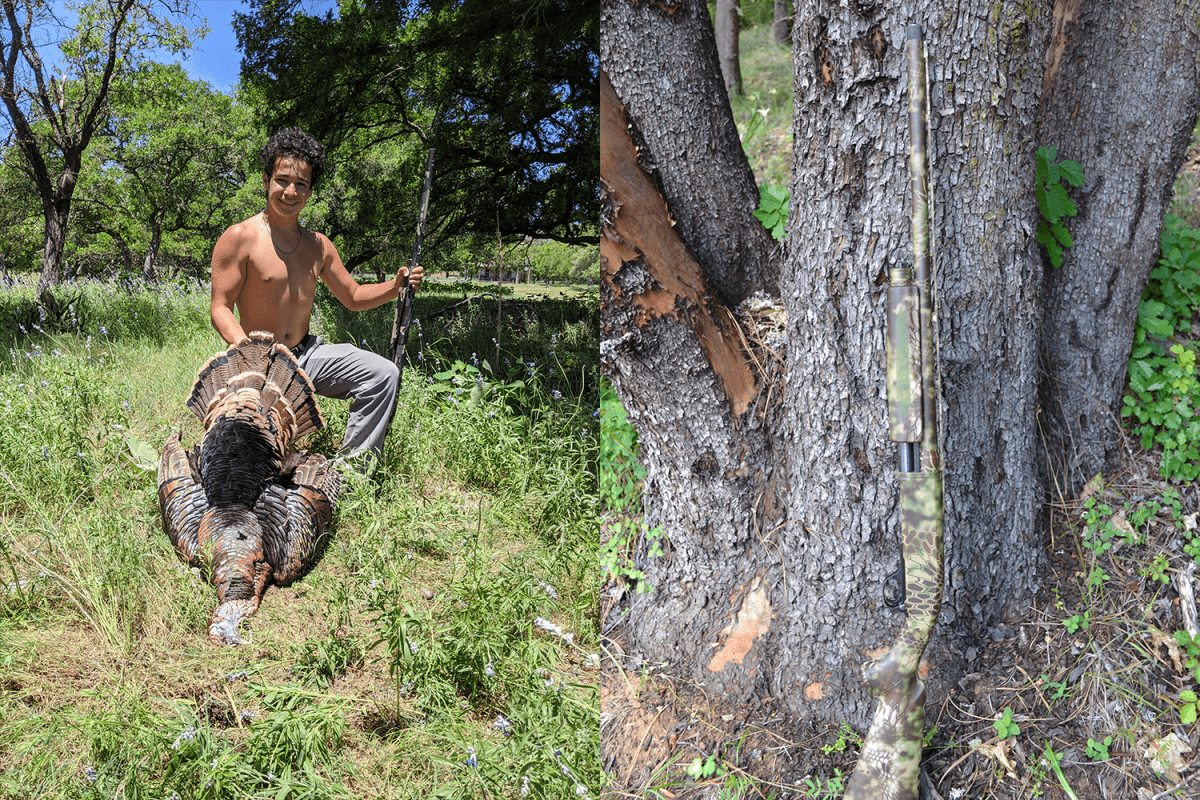Turkey Hunting Tips and Tricks

It’s finally here, the time you’ve waited all year for: turkey hunting season. It’s time to pull out your camo and tie your boots tight as turkey season approaches.
Turkey season doesn’t start on opening day and remains far from a sit-and-wait style of hunting. These tips and tricks will give you the upper hand and advantage to land one of the most beautiful games out there.
Pre-Season
While you can’t bag that bird early, there’s a lot of work to get done before opening day. Understanding your game will give you the upper hand and ensure you’re in the right spot before you tuck in and disappear into the brush.
These tips should be done pre-season but continue into the hunt.
Scout the Land
Before the season, make your way to your hunting spot and look for traces of turkey, such as game runs, tracks, scat, or scratches.
You would never forget small details, right?
We’re all human, and with a season that starts in early fall and runs into spring, you’ll be able to watch and understand your local flocks. Print or sketch a map you can draw on with room or another page for notes. Take note of everything, the good and the bad. If you check a ridge and there are no visual signs, take note of that.
This should give you an understanding of your local flocks activity.
Roosting Patterns
Just before the season begins, you’ll want to return to your spot to begin tracking the flock once again, especially in the evening, to figure out roosting patterns.
Turkeys are large birds that spend much of their time walking around and grazing from the land. At night, turkeys fly into trees to roost. In most cases, a flock will remain in the tree through the night unless spooked by a predator or something else.
By tracking the flock the night before a hunt, you will have a general idea of where they will roost and where they will be the next morning.
Trail Cams
Setting up trail cams will allow you to see not only the turkey in an area but receive a deeper understanding of patterns and actions of all wildlife in a given area.
Trail cameras can be set up and watched year-round, even when you’re busy with other things.
Your trail cams must go unnoticed to avoid changing the flocks' habits. Wrapping your cams can help them blend in and disappear into the wilderness.
Practice Calling
Nearly every animal known communicates in some way, shape, or form. For turkey, they communicate with each other through a wide range of sounds and actions.
What are you saying with your call?
Incorrect calling practices could push the turkey away from you, leading to a bad overall experience. Taking the time to practice pre-seasons will ensure your calling is well-rounded.
Choose Your Camo
Now that you’ve chosen an area to hunt, it’s time to pull out the correct camo clothes and wrap your gear to match.
Proper camouflage focuses on color and pattern.
Using GunSkins wraps, you can customize your gear to blend in, creating a perfect match. Bring new life to old guns, bows, and other gear.
GunSkins wraps add a layer of protection to your gear—no more risk of scratches and other damage that could cause rust or further deterioration.
Worried about removal or other regions you may hunt? Heat GunSkins with a heat gun or hairdryer, and it simply peels away. You can wrap your next design in the comfort of your home.
GunSkins are reasonably priced, allowing you to make changes and create a set of one-of-a-kind gear. Use GunSkins to wrap an entire piece of gear or as a detailed inlet.
During the Hunt
Now that season has started, the chase is on. Turkey can be smart and are quick to evade if they feel something isn’t quite right. Here are just a few examples of what to avoid during a hunt if you want to bag a turkey:
- Making an unnatural sound
- Making early or incessant calls
- Moving too suddenly or too quickly
- Getting too close to the roost
- Not blending well with the environment (good camo)
GunSkins wraps can help with the last point on the list and blend your gun seamlessly for a successful turkey hunt.
Arrive Early
It’s important to arrive early at your spot. When walking through nature, the wildlife takes note and tends to become more quiet and more alert.
When other animals are acting out of the norm, the turkey will act more cautiously and leave the area.
By arriving at your blind early, you give nature a moment to calm down and normalize before the turkey becomes active. This gives you more time to ensure everything is in order, and if something happens and you need to change to an alternative spot, you have time.
Alternative Spot
You’ve found that perfect spot overlooking a clearing. Everything seems in place. What do you do when something happens?
It’s good to have a backup spot just in case. This will ensure the day’s hunt isn’t ruined by a loud noise or mistake.
Circle Behind
Did your target flock pass by a bit far, and the calls aren’t quite getting them to turn? Thickets and downed trees may discourage turkey from heading your way, while the risk of the unknown dangers could be discouraging.
Consider picking up and circling the backside of the flock and calling. They are more likely to feel safe and walk through an area they just walked through.
Call the Hens
Using a hen call, your goal is to grab the attention of the gobbler and bring him in, interested and looking for love.
A gobbler surrounded by a flock of hens may not be as interested in your calls. So how do you grab their attention?
Consider switching your tactics and calling the hens from the flock. As a flock animal, they are likely to move as a group. Calling the hens could be just what you need to pull that gobbler your way.
Stop Calling
You could have a gobbler’s attention and see they are getting worked up, but they just won’t head your way.
It may be time to stop calling.
The gobbler may become interested if you, “the hen calling”, have found another gobbler within his area. The lack of calls could create interest or concern and bring the flock right to you.
Scrape Leaves
Sometimes the best calls are free. When turkeys are looking for food, they scrape and pull the leaves back to check the ground. Running your hand across the ground can mimic these ground scraping sounds, informing nearby turkey of possible intruders or food.
Hunting Vests
From a tree stand or ground blind, movement can ruin a hunt. Regardless of what you need to grab, you need to reduce how much you move.
While a backpack is great for carrying gear into a spot, accessing that gear during your hunt could be loud and disorganized.
Hunting vests allow you to organize your needed gear, such as calls and rounds, in an easy-to-reach spot strapped to your chest.
End Day Stalk
Near sunset, turkeys are going to return to or find a new tree to roost.
Pay attention and find what tree they are heading to. Look for a good path down from the tree into a clearing, they’re unlikely to drop from the tree into heavy brush or other trees. Consider what route they’ll take once they drop.
Find where you’re going to set up and the path you’ll use to get to that spot. Remember you’ll be returning in the darkness of night, so make sure your tailback is easily seen and remove any large branches or other hazards that could cause a large noise the next morning.
Early Morning
Again, arrive early.
This is even more important when making your way to a new spot you haven’t tracked before. This way, you can take your time sneaking into your spot.
Take your time to avoid excess noise or mistakes.
Don’t Rush Calling
When you first hear the flock plop to the ground, it’s easy to get overly excited and start calling, but it may be too early.
Imagine you just crawled out of bed, and someone instantly starts beating on your door. That’s suspicious.
Give the entire flock time to drop from the tree and begin feeding before calling.
Use Decoys
Decoys are a great way to grab physical attention when hunting. From simple decoys to high-end moving decoys, your goal is to grab the gobbler's attention just enough to bring them in range.
It helps to know where the flock is roosted or where they will be coming from. The goal is to cause the flock to walk across your clearing, giving you the most opportunity for a clear shot.
This means if the flock is to your front left, you’ll place your decoy to the front right giving the birds something to look at instead of you.
Get Out There
The best tip to improve your hunt is to get out there and go hunting.
Pay attention to what works and what doesn’t and take note of everything. The birds in your region may be more cautious of certain things or less jumpy to other things. It’s important for you to learn your flock.
A proper blind and camo are essential to not being seen. GunSkins wraps allow you to customize and protect your gear or the hunt: No more black gun barrels or green calls. Match your gear to the surroundings.
Show off that trophy and custom gear for a chance to win big.
Sources
Pre-Season Turkey Scouting Tips - Backcountry Hunters and Anglers




0 comments